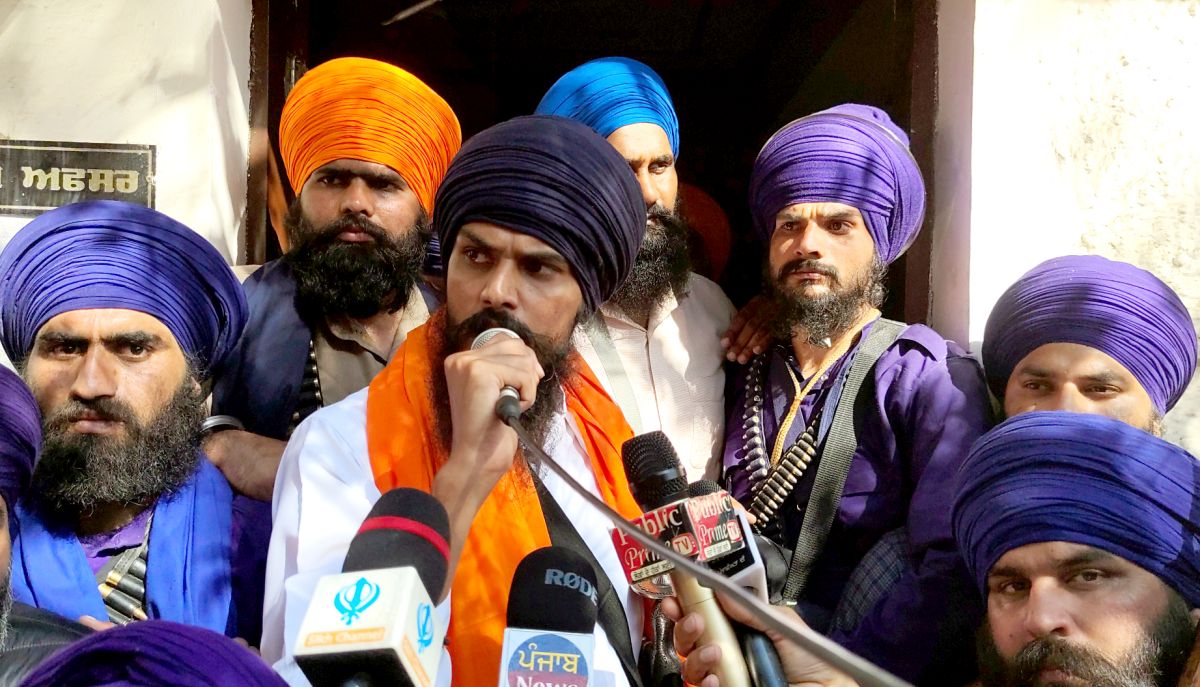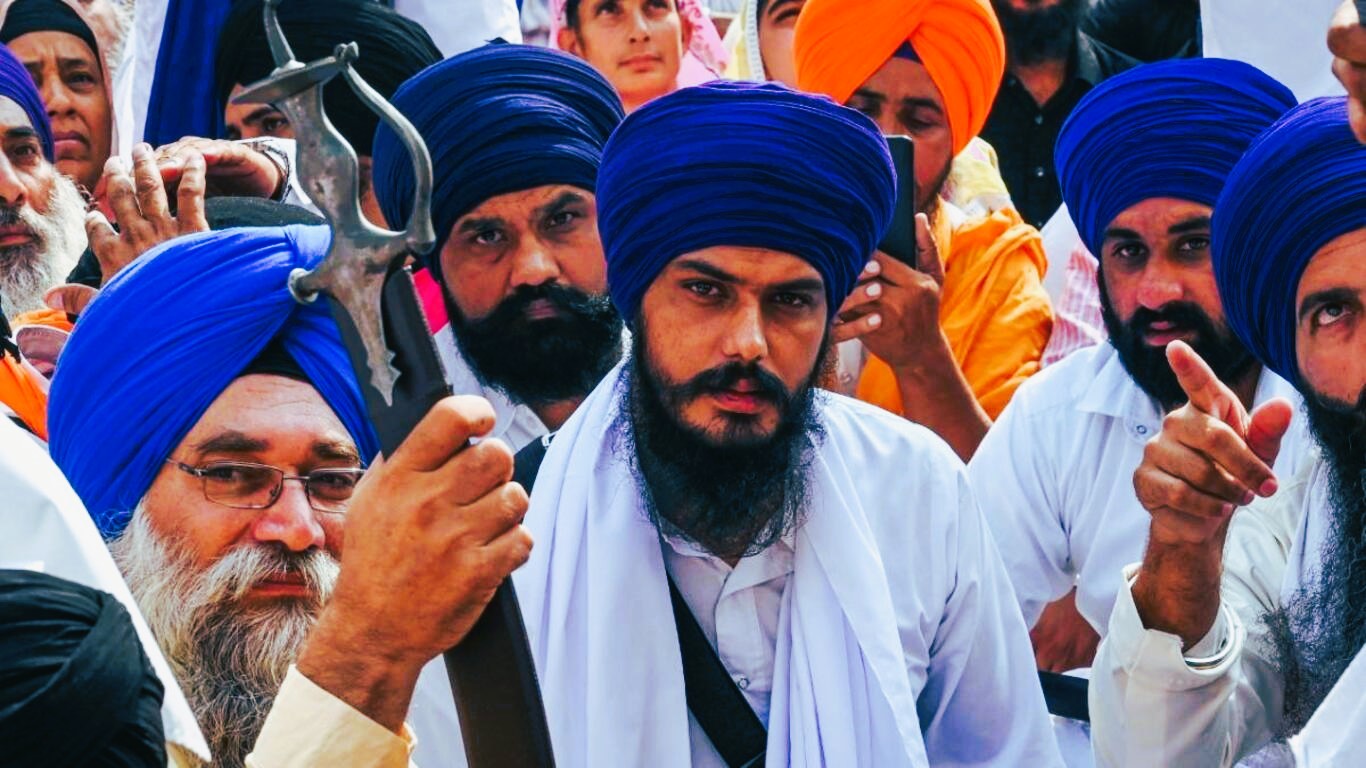The factors behind the rise of Khalistan extremism are complex and multifaceted. Using the 1984 anti-Sikh riots as a foundation, various members of the Sikh diaspora, supported by Pakistan have successfully been targeting the youth to keep the Khalistan issue simmering. Coming back to the recent trends leading to the revival of this menace, Indian agencies suspect ISI’s role behind the rise of Amritpal Singh in order to plant a “real, flesh and blood cult leader” and to breed separatist sentiments particularly among Sikh youths who are increasingly following the social media.
In the backdrop of the prevailing political instability in Punjab, Pakistan’s state sponsored and non-state actors, in collaboration with West-based pro-Khalistani elements, have been desperately making attempts to revive the saga of militancy in Punjab. It was manifested on 23rd February this year, when hundreds of followers led by the UAE returned taxi driver turned politician Amritpal Singh, the self-styled Chief of a pro-Khalistani outfit ‘Waris Punjab De,’ clashed with the police outside the Ajnala police station near Amritsar. Amritpal Singh is being actively supported by Pakistan backed Inter-Services Intelligence (ISI) and other anti-India elements around the world. He moves around with an army of heavily armed Sikhs, delivering provocative speeches and in doing so, is trying to establish himself as ‘Bhindranwale 2.0.’ He and his supporters not only brandish firearms publicly, but are also issuing threats to people. Amritpal was in the headlines for his recent threat to Union Home Minister Amit Shah stating that Shah’s “fate will be similar to that of former prime minister Indira Gandhi.”

A brief history of the entire Khalistan movement needs to be highlighted here. Khalistan, or ‘Land of the Khalsa’, is the name given to a proposed sovereign state in North India, particularly the Punjab region and parts of Haryana, Himachal Pradesh and Rajasthan. Since the concluding years of the British Raj, calls for a separate Muslim state (Pakistan) were joined by somewhat quieter demands for a separate Sikh state, made up of regions in the north of India where Sikhs were in the majority. Post-independence, by the 1980’s, grievances of Indian Sikhs grew, and exploded in the aftermath of the Operation Blue Star launched by the Indian Army at Sri Harmandir Sahib (the Golden Temple), in order to flush out the Khalistani terrorists led by Jarnail Singh Bhindranwale. This culminated in violent incidents, from the world’s deadliest aviation attack pre-9/11 (the downing of Air India Flight 182) to the assassination of PM Indira Gandhi and the resultant 1984 anti-Sikh riots in India.
The factors therefore behind the rise of Khalistan extremism are complex and multifaceted. Using the 1984 anti-Sikh riots as a foundation, various members of the Sikh diaspora, supported by Pakistan have successfully been targeting the youth to keep the Khalistan issue simmering. Coming back to the recent trends leading to the revival of this menace, Indian agencies suspect ISI’s role behind the rise of Amritpal Singh in order to plant a “real, flesh and blood cult leader” and to breed separatist sentiments particularly among Sikh youths who are increasingly following the social media. Amritpal’s social media account shows that he is a fierce critic of the Modi government and even criticised the abrogation of Article 370 in J&K as well.
The easy access to new tools viz. internet, mobile phones, social media handles, deep-fake technologies and such other tools facilitated by globalization has proved to be a boon for anti-Indian elements to revive Khalistan narrative by propagating religious and fundamentalist agenda and circulating fake news like during farmers agitation to instigate Punjab youth with the backing of ISI. Organizations like Sikhs for Justice, Khalistan Commando Force (KCF), Babbar Khalsa International (BKI), etc. have been running misinformation campaigns on social networking sites like Twitter, Facebook, Instagram, and WhatsApp.
A senior fellow at Observer Research Foundation, Sushant Sareen observed that there has been a greater focus on spreading Khalistani propaganda online, since it’s the cheapest, most cost-effective way to spread propaganda, and Pakistan has been openly funding and supporting these efforts. Hate videos featuring people who are trampling and tearing Indian flag and shouting slogans in support of Khalistan has been in circulation in recent past. Some accounts have Indian-sounding names, but upon tracking the IP addresses, they turn out to be based either in Pakistan or countries like UK, Canada etc.[i]
Recently Australia has also witnessed steep rise in the Pro-Khalistan movement support. Khalistan supporters targeted the Indian Consulate in Brisbane on 23 February 2023. Earlier in January, the Khalistani supporters had vandalized the historic Shri Shiva Vishnu Temple in Melbourne on the occasion of “Thai Pongal” festival. The Swaminarayan temple in Melbourne was also defaced by ‘anti-social elements’ with anti-India graffiti.
Punjab has for long been peaceful, but the movement which seems to continue continues to live among some Sikh communities overseas, is nothing but a planted narrative. It presents a completely fabricated version of history and there is absolutely nothing organic about it. Noted Canadian journalist Terry Milewski holds the view that “the Sikh diaspora is composed predominantly of people who don’t want to live in India… These people include many who remember the bad old days of the 80s”, and thus the support for Khalistan remains stronger there. The deep-rooted anger over Operation Blue Star and the desecration of the Golden Temple continues to resonate with some in the newer generations of Sikhs.[ii] However, even as the legacy of Bhindranwale as a martyr continues to survive in the memories of some disgruntled Sikh NRI’s, this has not manifested into tangible political support for the Khalistan cause. Milewski further points out that – “If you look at the Khalistan movement, you wonder where the rationale is. Where is the description of what Khalistan is supposed to be? The Khalistanis themselves don’t describe it precisely because, other than a motive of revenge for the blood extracted from Sikhs in 1984 after the assassination of Indira Gandhi, there’s really no description anywhere of what kind of state would Khalistan be.”[iii]

Even former pro-Khalistani leader, UK based Jaswant Singh Thakedar said those in Punjab don’t demand the referendum and added that people in Canada, US or Britain don’t have the right to vote for the secession. He termed it as a ‘pakhand‘ (sham) to mislead people. Talking on last month’s Ajnala violence by supporters of ‘Warris Punjab de’ chief and Khalistani separatist leader Amritpal Singh, Thakedar said he knows nothing about the history of Sikhism, let alone that of Khalistan but has garnered a lot of name out of it.[iv]
As already mentioned, various attacks and vandalism incidents by Khalistan’s proponents have augmented in various countries like Canada, Australia, the UK, the US, etc. The Indian leadership has called out on the hypocrisy of these governments several times and now seeks an action-oriented approach. Pro-Khalistanis have been insinuating a panic-stricken environment with a hollow and redundant approach. They have no on-ground coherent vision to support their cause.[v] These anarchists need to come to terms with the fact that they are waging a losing battle. The international community will not support them at any cost. Since their trump card to revive the repackaged Khalistan movement miserably failed on Indian soil, they have resorted to Plan B, which is to confuse the public through fake propaganda and deceptive narratives of human rights, civil liberties etc. These scroungers and freeloaders have been constantly harping upon the fact that the Indian state is oppressing and violating the human rights of the Sikhs and questioned the grounds for the arrest of Amritpal Singh. But in doing, they have garnered ill light for themselves only.
These separatist elements as a matter of fact, have never seemed to have a coherent rationale and have never enjoyed any kind of support among the majority of Sikhs. Also, these people often tend forget that Sikhs have been a successful community in India, whether be in terms of education or prosperity. They form just about 2% of the total country’s population, but have been extremely successful in business, bureaucracy and most importantly, the Indian Armed Forces. The Sikh community has also produced a President and a Prime Minister for the country. Whereas the diaspora is composed predominantly of people who don’t want to live in India. That’s obviously why they are living in Canada or West London or California, because they chose to leave. These people include many who remember the bad old days of the 80s and have no experience of ‘New India’ , guided by the principle of ‘Sabka Sath Sabka Vikas’ that is enroute to becoming a global powerhouse. In fact, the new generation among the Sikh diaspora doesn’t even have much memory of all that. So, how long this movement will survive even in the diaspora is a question which needs to be asked. By all means, it seems to be failing pretty fast.
Ever since independence, various destabilising forces have been challenging the unity and integrity of India every now and then. However, the democratic foundation of India tis so strong that it can never fall prey to such the gimmicks, aiming to disintegrate the nation. India well and truly stands like the ‘lighthouse amidst the storm.’ All said and done, the resurgence of Khalistan extremism in India nevertheless remains a cause of concern for the Indian government. Although substantial ground support is missing, the logistical support from a section of the diaspora and Pakistan is trying to revitalize the once weakening movement. Our Indian defence and intelligence agencies need to be pro-active and effectively counter the misinformation campaign against Indian establishments. The Khalistanis will never be successful in carving out a new sovereign state for themselves but the fact remains that anti-Indian forces like ISI as well as traitors like the Urban Naxals, Drug Mafia etc shall leave no stone unturned in making use of these parasitic elements to strike at the very roots of our democracy and sovereignty, thus serving their malicious and nefarious designs. As for Pakistan, it doesn’t care at all about helping the Sikhs securing a separate homeland for themselves. Rather, it is always on the lookout to seize any possible opportunity to destabilize India, at a time when that country itself is facing an economic and political turmoil. The entire Khalistani fiasco therefore needs to be resolved with utmost priority by the Indian government.
(The author works as a Senior Research Associate with Dr. Syama Prasad Mookerjee Research Foundation. Views expressed are his personal. He can be reached out at biresh.chaudhuri@gmail.com.)
References :
[i] http://www.indiandefencereview.com/khalistan-movement-rising-from-the-ashes/
[ii] https://indianexpress.com/article/explained/explained-history/amritpal-singh-khalistan-movement-punjab-history-8465056/
[iii] https://bharatabharati.in/2021/08/23/terry-milewski-on-the-khalistan-movement-adrija-roychowdhury/
[iv] https://www.hindustantimes.com/india-news/khalistan-referendum-is-work-of-isi-sikh-separatist-leader-101679019013793.html
[v] https://organiser.org/2023/03/20/165601/bharat/khalistan-saga-a-pandora-box-of-crocodile-tears-and-misinformation-war/
